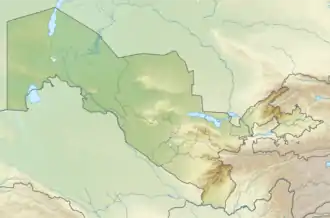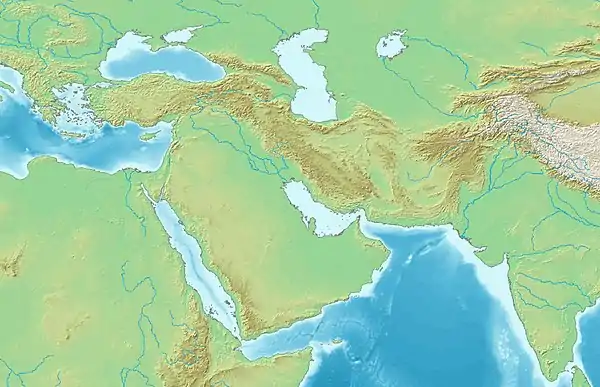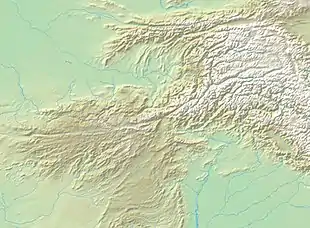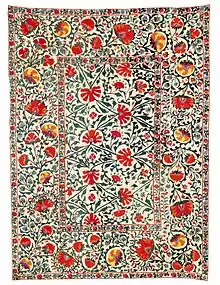Shahrisabz
Shakhrisabz (Uzbek Cyrillic and Tajik: Шаҳрисабз; Persian: شهر سبز, romanized: shahr-e sabz: "city of green" / "verdant city"; Russian: Шахрисабз) is a district-level city in Qashqadaryo Region in southern Uzbekistan.[2] The Economic Cooperation Organization (ECO) has selected Shakhrisabz as its tourism capital for 2024.[3]
Shahrisabz
Шаҳрисабз | |
|---|---|
City | |
.JPG.webp)   _(6018370667).jpg.webp)    Left: Statue of Amir Temur and heritage twin buildings in Ak-Saray Palace, Jahangir Mausoleum, Shahrisabz Kok-Gunbaz Mosque, Panoramic view of Shahrisabz, from Ak-Saray Palace
Right: Shahrisabz Ancient Chorsu, Shahrisabz Wall, Shahrisabz Mosque (all items were from above to bottom) | |
 Shahrisabz  Shahrisabz  Shahrisabz | |
| Coordinates: 39°03′N 66°50′E | |
| Country | Uzbekistan |
| Region | Qashqadaryo Region |
| Population (2022)[1] | |
| • Total | 142,700 |
| Time zone | UTC+5 |
| Official name | Historic Centre of Shakhrisyabz |
| Criteria | Cultural: (iii), (iv) |
| Designated | 2000 (24th session) |
| Reference no. | 885 |
| Endangered | 2016– |
It is located approximately 80 km south of Samarkand, at an altitude of 622 m. Its population is 140,500 (2021).[1] Historically known as Kesh or Kish, Shahrisabz was once a major city of Central Asia and was an important urban center of Sogdiana, a province of the Achaemenid Empire of Persia. It is primarily known today as the birthplace of 14th-century Turco-Mongol conqueror Timur.[4]
History

Formerly known as Kesh or Kish ("heart-pleasing") and tentatively identified with the ancient Nautaca, Shahrisabz is one of Central Asia’s most ancient cities. It was founded more than 2,700 years ago and formed a part of the Achaemenid Empire or Persia from the 6th to 4th centuries BC. Throughout this period Kesh remained an important urban center of Sogdiana, a major province within the Empire. Documents from the late Achaemenid period speak of the renovation of the city's walls.[5] It has been known as Shahrisabz since the Timurid era.[6]
Alexander the Great's general Ptolemy captured the satrap of Bactria and pretender to the Persian throne, Bessus, at Nautaca thus ending the once great Achaemenid Empire. Alexander the Great chose to spend his winters and met his wife Roxanna in the area in 328-327 BC. Between 567 and 658 AD rulers of Kesh paid taxes to khagans of Turkic and Western Turkic khaganates. In 710 the city was conquered by the Arabs[5] and following the Mongol conquest of Khwarezmia in the 13th century, the region came under the control of the Barlas tribe, all of whose lineages seem to have been associated with this region.[7]
As part of the Turkic Kaganate
In VI-VIII centuries Kesh was a part of the Turkic and West Turkic Kaganates. In VIII century the ruler-malik of Khuzar (Kesh) was Turk Subugra. Under Ton-Yabgu-Kagan (618-630) the power of Turks strengthened in Sogdia. New campaigns to Tokharistan and Afghanistan pushed the borders of the state to northwestern India. Ton-Yabgu Kagan carried out administrative reform and appointed his representatives - tuduns - in the regions, including Sogdia, to monitor and control the collection of tribute. It is assumed that he issued his coins with the inscription "Tun yabgu kagan".
An ancient Turkic tribe were the Khalaj people, who in the Early Middle Ages lived in Tokharistan - the modern territories of southern Uzbekistan, Tajikistan and northern Afghanistan.[8]
The Turks of Central Asia worshiped the following deities: Tengri (sky), Umai (Mother Goddess), Yer-sub (Earth-Water) and Erklig (Lord of Hell), among which Tengri held the predominant position. Tengri was the most important.[9]
Arab conquest
Kesh was conquered by the Arabs in the 8th century. During the Arab invasion, the Kashkadarya Valley and especially Kesh was the epicenter of an anti-Arab and anti-Islamic liberation movement led by Al-Muqanna, known in history as the "Revolt of the Men in White Clothes".
The resistance eventually led to the decline of the capital city. In 701-704, there were battles between Turks and Arabs at Nessef and Kesh.[10]
During the Samanid dynasty, urban life gradually moved to the southwest of old Kesh, the site of the large village of Barknon.
Karakhanid era
In 1038, Ibrahim ibn Nasr, who also was known as Böritigin, son of the conqueror of Transoxiana, captured Chaghaniyan, from where he invaded central Transoxiana. In 1040 he conquered Kesh. By the 10th century, the Karakhanid state had a literary language that continued the traditions of ancient turkic written texts. The official Karakhanid language of the 10th century was based on the grammatical system of ancient Karluk dialects.[11]The Islamization of the Karakhanids and their turkic subjects played a major role in the cultural development of turkic culture. In the late 10th and early 11th centuries, for the first time in the history of the turkic peoples, the Tafsir, a commentary on the Quran, was translated into the turkic language.[12] The 11th century scholar Mahmud Kashgari laid the foundations of turkic linguistics. He lists the names of many turkic tribes of Central Asia.
One of the famous scholars was the historian Majid al-Din al-Surhakati, who wrote "History of Turkestan", which outlined the history of the Karakhanid dynasty.[13]
During the reign of the Karakhanids, the new capital of medieval Kesh was finally formed. During the hegemony of the Khwarazmshahs (early 13th century), Kesh-Shakhrisabz was first enclosed by defensive walls.
The birthplace of Timur
Kesh was the birthplace of Timur in 1336, to the family of a minor local Barlas chief, and during the early years of the Timurid dynasty, the city enjoyed his considerable patronage. Timur regarded Kesh as his “home town” and planned it eventually to be the location of his tomb. However, during his reign, the center of activity shifted to Samarkand instead. In the era of Timur, masterpieces of world architecture were built: the Ak-Saray palace, the Dorusiodat memorial complex. [14] The city struggled for autonomy under Bukharan rule and the Russians helped the Bukharan emir conquering the city in 1870.
Historical sites

Several remaining impressive monuments from the Timurid dynasty have enabled the old part of the city to be inscribed on the UNESCO World Heritage List. However, destruction of vast areas of the medieval townscape in 2015 to create a park and tourist facilities have led to concern from UNESCO. It is possible that the listing could be lost.[15]
Timur's Summer Palace, the “White Palace” was planned as the most grandiose of all Timur's constructions. It was started in 1380 by artisans deported by Timur from the recently conquered Khwarezm. Unfortunately, only parts of its gigantic 65 m gate-towers survive, with blue, white and gold mosaics. Above the entry of the Ak-Saray are big letters saying: "If you challenge our power – look at our buildings!"
- Kok Gumbaz Mosque / Dorut Tilovat (Dorut Tilavat) Complex
A Friday mosque built in 1437 by Ulugh Beg in honor of his father Shah Rukh, its name meaning “Blue Dome”. Located immediately behind the Kok Gumbaz Mosque is the so-called “House of Meditation”, a mausoleum built by Ulugh Beg in 1438 but apparently never used for burials.
- Hazrat-i Imam Complex
East of the Kok Gumbaz is another mausoleum complex called Dorus-Saodat (Seat of Power and Might), which contains the Tomb of Jehangir, Timur's eldest and favorite son. The adjacent mosque is said to house the tomb of a revered 8th century imam Amir Kulal.
- Tomb of Timur
Behind the Hazrat-i Imam Emsemble is a bunker with a door leading to an underground chamber, discovered by archaeologists in 1943. The room is nearly filled with a single stone casket, on which inscriptions indicate that it was intended for Timur. However, the conqueror was buried in Samarkand, not at Shahrisabz, and mysteriously, his tomb in Shahrisabz contained two unidentified corpses.
Also of interest are medieval baths and an 18th-century bazaar.
In popular culture
In 1980s the Uzbek Soviet band Yalla wrote a song about Shahrisabz.
References
- "Urban and rural population by district" (PDF) (in Uzbek). Qashqadaryo regional department of statistics.
- "Classification system of territorial units of the Republic of Uzbekistan" (in Uzbek and Russian). The State Committee of the Republic of Uzbekistan on statistics. July 2020.
- "ECO declares Shakhrisabz as its tourism capital for 2024". Daryo.uz. Retrieved 2022-12-18.
- Pickett, James (2018). "Written into Submission: Reassessing Sovereignty through a Forgotten Eurasian Dynasty". The American Historical Review. 123 (3): 819. doi:10.1093/ahr/123.3.817.
Now a provincial city in the modern state of Uzbekistan, Shahrisabz is remembered primarily as the birthplace of Timur—if it is remembered at all.
- Pavel Lurje, (2009), 'KEŠ' Encyclopaedia Iranica (online)
- "Shahrisabz Travel Guide". Caravanistan. 13 April 2021. Retrieved 2021-04-13.
- B.F. Manz, The rise and rule of Tamerlan, Cambridge University Press, Cambridge 1989, p. 156–7
- Бартольд В. В., Сочинения т.5.М.,1968
- Стеблева И. В. К реконструкции древнетюркской религиозно-мифологической системы // Тюркологический сборник 1971 года. М., 1972
- Табари. История. — Т., 1987 год, с. 85
- ИСТОРИЯ И КУЛЬТУРА ТЮРКОВ В ЛИТВЕ. Сборник научных статей международной конференции. Vilniaus universiteto leidykla VILNIUS 2014, с.157-160
- Боровков, А.К. Лексика среднеазиатского тефсира: XII-XIII вв. М., 1963
- Introduction to The Jawami u’l-hikayat wa Lawami’ur-riwayat of Sadidu’u-din Muhammad al-Awfi by Muhammad Nizamu’d-din. London: Luzac & Co, 1929
- Golombek, L. Wilber, D. The Timurid Architecture of Iran and Turan. Vol 1. Princeton, N.J.: Princeton University Press. 1988
- Synovitz, Ron (28 March 2017). "Bulldozing History". Radio Free Europe/Radio Liberty. Retrieved 16 November 2019.

.jpg.webp)
